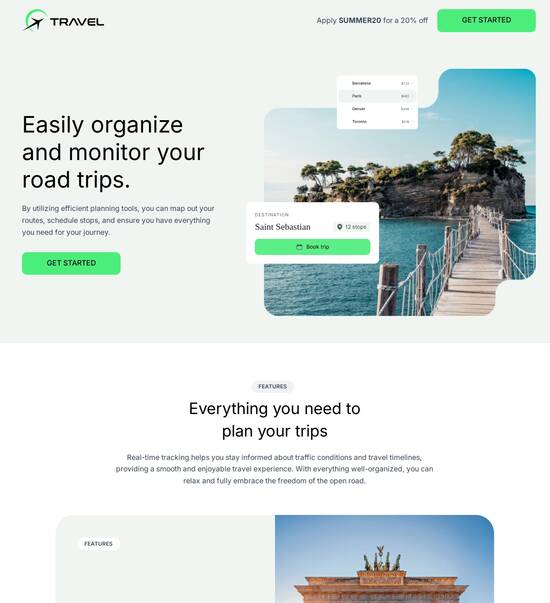
HTML/CSS optimized cart page template
Explore Similar TemplatesAbout template
Supercharge your cart page with HTML/CSS for outstanding performance! Learn more today.
Recommended templates

Easy to build without coding
With the intuitive drag-and-drop builder, anyone on your team can create high-converting pages without any knowledge of code or design. Make enhancements to your landing page with custom widgets using Javascript, HTML/CSS, or third-party scripts.

Multiple layouts for any industry and goal
Select from 500+ landing page layouts built to boost conversions across industry-specific scenarios. Customize them by adjusting fonts, adding images, and generating on-brand content with the AI assistant. Quickly scale with Instablocks® and Global Blocks that you can save, reuse, and update globally.

Loads fast and looks polished on any device
Every template is responsive, which means they present professionally on any device and load blazingly fast with our Thor Render Engine. You can also power them up with Google AMP technology to deliver an unparalleled mobile experience and drive higher conversions.

Robust analytics & experimentation
Get real-time updates and reporting across all your devices, showing the number of visitors, conversions, cost-per-visitor, and cost-per-lead. Launch AI-powered experiments, run A/B tests, and use heatmaps to analyze user behavior, then optimize your landing page to maximize conversions.







Easy to build without coding
With the intuitive drag-and-drop builder, anyone on your team can create high-converting pages without any knowledge of code or design. Make enhancements to your landing page with custom widgets using Javascript, HTML/CSS, or third-party scripts.
Multiple layouts for any industry and goal
Select from 500+ landing page layouts built to boost conversions across industry-specific scenarios. Customize them by adjusting fonts, adding images, and generating on-brand content with the AI assistant. Quickly scale with Instablocks® and Global Blocks that you can save, reuse, and update globally.
Loads fast and looks polished on any device
Every template is responsive, which means they present professionally on any device and load blazingly fast with our Thor Render Engine.
Robust analytics & experimentation
Get real-time updates and reporting across all your devices, showing the number of visitors, conversions, cost-per-visitor, and cost-per-lead. Launch AI-powered experiments, run A/B tests, and use heatmaps to analyze user behavior, then optimize your landing page to maximize conversions.
All the features you need to build lead-generating landing pages
Explore more featuresLearn how to build top-performing landing pages for any goal
FAQs
Leading the way in building high-performing landing pages





A step-by-step guide to mastering landing page optimization with Instapage
To maximize the efficiency of your digital marketing campaigns, leveraging powerful landing pages is essential. Instapage provides marketers with the tools necessary to design and optimize landing pages that not only attract visitors but also convert them into leads and customers. This guide will walk you through essential steps to harness Instapage effectively.
Understanding the purpose of landing pages
Landing pages serve as dedicated spaces that focus on specific campaigns, products, or services. Unlike regular website pages, they have a singular goal: lead generation or conversion. It’s crucial to understand this focus as you design each page.
- Define your goals: Clearly outline what you want your landing page to achieve, whether it's newsletter sign-ups, product demos, or sales.
- Create a compelling offer: Ensure that your offer is attractive enough to persuade visitors to share their information or make a purchase.
- Target your audience: Use analytics and market research to tailor your landing page content specifically to the audience you intend to reach.
Utilizing Instapage templates
Instapage offers over 100 conversion-optimized templates that simplify page creation without needing coding skills.
- Choose a template: Select a design that aligns with your branding and campaign goals.
- Customize easily: Utilize the drag-and-drop functionality to add images, text, and lead generation elements seamlessly.
- Preview your page: Before going live, ensure your page looks great on both desktop and mobile devices.
Implementing effective optimization techniques
To ensure your landing pages are performing well, it's important to regularly test and optimize them based on user behavior and analytics data.
- Use A/B testing: Instapage’s built-in A/B testing tools allow you to compare different versions of your landing page to see which performs better.
- Analyze heatmaps: Understanding where users click and scroll can inform necessary layout changes to enhance conversions.
- Review analytics: Regularly check analytics dashboards to assess performance metrics like conversion rates and drop-off points.
By following these steps and leveraging Instapage’s powerful features, you can create landing pages that not only attract traffic but also convert visitors into tangible results.
As you implement these strategies, remember to continually adapt to your audience's needs and trends to remain effective.
Ready to elevate your marketing strategy? Start using Instapage today and see how effortless landing page creation and optimization can be!
People also ask about HTML/CSS optimized cart page template
HTML/CSS optimized cart page template: Enhancing e-commerce experiences
Understanding the importance of an optimized cart page template
The cart page is a pivotal component of any e-commerce website, with its design and functionality significantly affecting user experience. A well-optimized cart page creates a seamless navigation experience, ensuring users can easily view and modify their selections. This ease of use directly impacts user satisfaction and retention, transforming casual browsers into committed buyers.
Moreover, the cart page serves as a crucial touchpoint in the checkout process. It acts as a bridge between product selection and final purchase, offering users a chance to review their items, alter quantities, or even discard unwanted products. This interaction is critical; any friction encountered here can prompt users to abandon their carts. Therefore, creating a smooth experience is not just preferred – it’s essential for minimizing cart abandonment.
Design and performance collectively influence conversion rates. A visually appealing and fast-loading cart page can significantly enhance a user’s likelihood to complete a purchase. In addition, elements such as progress indicators during checkout and intuitive design features can keep users engaged and foster trust, ultimately leading to higher conversion rates.
Key features of an HTML/CSS optimized cart page template
Responsive design: Ensures that the cart page is accessible and functions well on a variety of devices. Mobile-friendly layouts are essential given the rise of mobile commerce.
Streamlined checkout process: Simplifies the steps required to complete a purchase by offering integration with various payment gateways and clear options for guest checkout.
Visual appeal and theme consistency: Cohesion with brand identity creates a familiar shopping environment for users, making it more likely for them to convert.
Real-time previews and dynamic content updates: Provides users with instant feedback on their cart while enhancing user engagement with live updates.
Accessibility for diverse communities: Ensuring compliance with the Web Content Accessibility Guidelines (WCAG) allows for a wider audience reach.
Technology stack for an optimized cart page
An optimized cart page heavily relies on the technologies of HTML5, CSS3, and JavaScript. Each serves a unique and integral role in the overall functionality and aesthetics of the cart experience. HTML5 provides the structural foundation for the cart page, while CSS3 ensures that the design is visually appealing and responsive. JavaScript is crucial for adding interactivity, allowing users to update their cart contents dynamically.
Additionally, integrating front-end libraries and frameworks such as Bootstrap or Tailwind CSS can expedite the design process and ensure consistent functionality. While pre-built templates offer quick solutions, custom solutions allow for more flexibility tailored to specific requirements. Performance optimization techniques, like code efficiency and lazy loading images, are vital for minimizing load times and enhancing the user experience.
Crafting content that converts
Persuasive text elements: Utilizing compelling call-to-action placement, scarcity and urgency in messaging can create an incentive for users to complete their purchases.
Error handling and resolution: Structuring responsive error messages can guide users through common formatting issues, thereby reducing cart abandonment.
Displaying trust elements: Incorporating customer reviews and ratings alongside secure payment icons builds trust; transparency in pricing can further solidify consumer confidence.
Community insights and best practices
Engaging with user communities for feedback is pivotal in the continuous improvement of cart page templates. Learning from collective experiences helps identify pain points and encourages user-centered design approaches. Data from analytics can provide insights into user behavior, allowing marketers to assess and iterate on cart performance effectively.
Moreover, utilizing feedback loops enables businesses to adapt and enhance user experience regularly. Observing user interactions reveals valuable trends and preferences that can inform future optimizations and ensure that the cart page remains effective and relevant to changing customer needs.
Examples of successful cart page templates
Case studies: Highlighting innovative designs from various industries shows real-life applications and how these features translate into increased sales.
Comparative analyses can illuminate the key differences between outdated cart pages and optimized templates, emphasizing the long-term benefits of investing in quality design.
Access and collaboration for optimizing cart pages
Collaboration between teams responsible for template development is essential. Cross-functional cooperation can lead to more innovative solutions and ensure that different perspectives are considered. Utilizing tools for collaboration and version control can facilitate this process, making updates and revisions easier.
Adopting best software practices for project management can streamline production. Regular updates to technology and content not only keep the cart optimized but also ensure it aligns with current trends and expectations from users.
Frequently asked questions about cart page optimization
There are many concerns surrounding HTML/CSS templates, particularly regarding their implementation and potential limitations. Often, misconceptions exist about the capacity of these templates to meet the diverse needs of e-commerce stores. Addressing these points clearly can help demystify the optimization process and encourage businesses to adopt effective cart solutions.
Furthermore, strategies for overcoming obstacles in implementation need to be systematically shared with teams involved in the development process. Open discussions about challenges can provide clarity and support, fostering a more effective collaboration aimed at optimizing the cart page.
Future trends in cart page design and technologies
User expectations are constantly evolving, which urges businesses to stay ahead of the curve in cart page design. Predictions indicate an increasing reliance on technology that enhances personalization in the shopping experience. As artificial intelligence becomes more prevalent, it will shape how cart pages adapt to individual consumer preferences.
Moreover, the integration of augmented reality and virtual reality technologies in shopping experiences could redefine how customers interact with their carts. These advancements are set to provide immersive experiences, allowing consumers to visualize products in new ways, ultimately transforming their shopping journeys.
Ready to skyrocket conversions?
Supercharge your ad campaigns with high-performing landing pages
Get started














